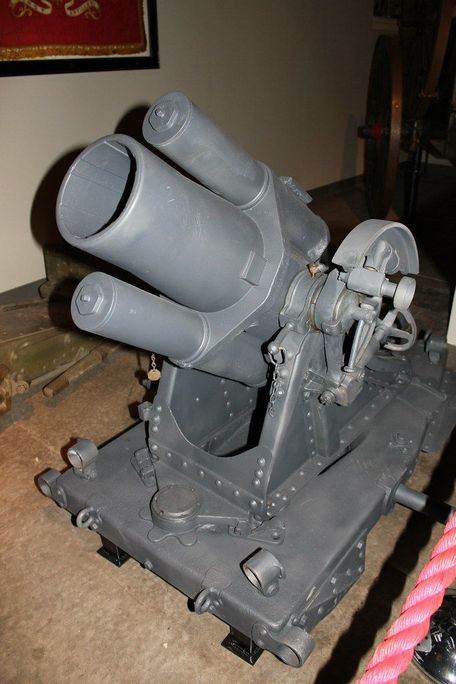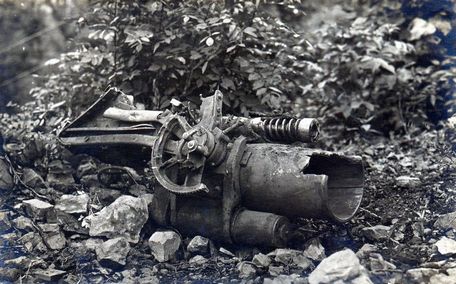17cm Medium Mortar History
The 17 cm medium mine thrower was a portable mortar (or "mine thrower") used by the German Imperial Army during the First World War. Understanding the importance of this siege weapon during the Russo-Japanese War (1904-1905) - especially when it was used to destroy fortifications during the siege of Port Arthur, the Germans embarked on a mortar construction program, producing Several excellent minesweeper-type weapons were obtained, all carried by two-wheeled wagons managed by several employees.
Since their main enemy in a total war would be France and its series of frontier fortresses, the mine-thrower itself would be an extremely important siege weapon for the Germans and their intent to advance on Paris itself. The 17cm Medium Mine Launcher - also known as "17cm Millimeter Wave" - ??was produced by the German company Rheinmetall from 1913 and adopted by the Imperial German Army in the same year.
When the war began in August 1914, only about 150 were available. Production continued until the end of the war in 1918, by which time around 2,360 had been produced, demonstrating the importance of the weapon at the end of the conflict.
Mine throwers have a useful role on the battlefield, destroying fixed, fortified enemy positions, often with machine gun teams, artillery systems, or both. In any case, these forts prevented further advancement of ground forces, and mortars provided a solution. This weapon type can also be used to clear field obstacles (eg, barricades, barbed wire) that threaten or deter Allied troops, cavalry, and vehicles.
The 17cm mmWave is designed so that it can engage these targets at range with a short rifled barrel, providing good accuracy. The 170 mm (6.69 in) 110 pound shell is unique to 17 cm mmWave weapons as it is designed with a thin outer shell that allows for more internal filling and therefore more explosive power inside. The shells were fired into an open muzzle load - the tube ended in a normal muzzle-loading mortar (still in use today).
A hydraulic spring suspension system provides the necessary recoil, and the trolley's wheels are usually removed prior to launch. However, the nature of the wheeled cart allowed a team of four to hold the gun in place with some work.
With a total weight of 1,065 pounds, it certainly requires several crew members (or pack animals) to move around. A pit was dug to protect the gun and rifle squad. May and Elevation provide projectiles between +45 and +90 degrees, and traverse is limited to 25 degrees on both sides.
A trained aircrew can fire 20 rounds per minute at a range of 1,700 yards, but greater accuracy can be achieved at ranges below 325 yards. Sighting is carried out by means of a panoramic sighting device integrated into the design.
After some practice, the original 17cm mmW gave way to a revised design with a longer barrel that increased overall range. The original version had a barrel length of just over 2 feet, while the modified version adds another 5 inches longer. As a result, manufacturing changes resulted in two different designations - the early short barrel version became 17 cm mmW a/A ("old art"), and the later long barrel version became 17 cm mmW n/A ("Art Nouveau").
They simply refer to the "old" and "new" tags as "old" and "new" respectively.
In action, the 17cm mMW series performed well. They are used by engineering units tasked with destroying enemy fortifications, obstacles and various positions. Huge 170mm shells can undoubtedly provide firepower to targets and completely destroy concrete and steel structures with ease.
However, the weapon was difficult to maneuver in the heat of battle and confined spaces, so designs from the early days of the war gave way to a more streamlined, lighter shape by the end of the war. In addition to their explosive base projectiles, this mine launcher can use incendiary and gas bombs to further enhance the hellish nature of trench warfare.
17cm medium mortar Specification
Roles
- Indirect Fire/Siege/Area Effects
Dimensions
646 mm (25.43 in)
646 mm (25.43 in)
1,064. 483.00 kg
Panoramic optics.
Performance
Muzzle load, propellant
656 feet per second (200 meters per second)
20 rounds per minute
984 ft (300 m; 328 yd)
Changes
17cm medium mortar - base series code; produced by Rheinmetall between 1913 and 1918; 2,361 copies made.
17 cm mmWave - abbreviated Bundeswehr name
17cm Medium Mortar a/A - First production mark to fit 2ft, 1" L/3. 8 barrels.
17cm Medium Mortar n/A - Modified production markings to fit 2ft, 6in L/4. 5 barrels; overall range expanded.








